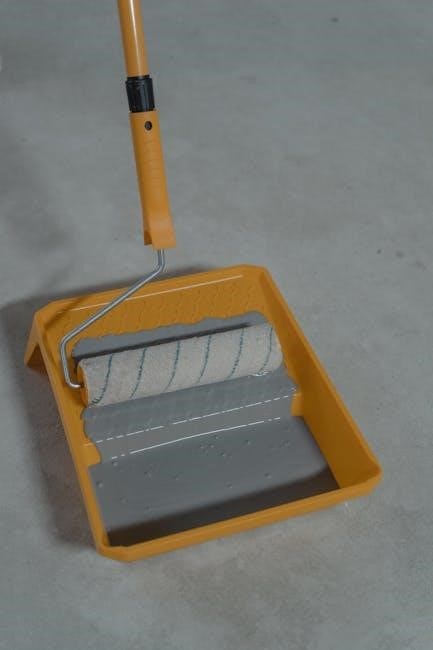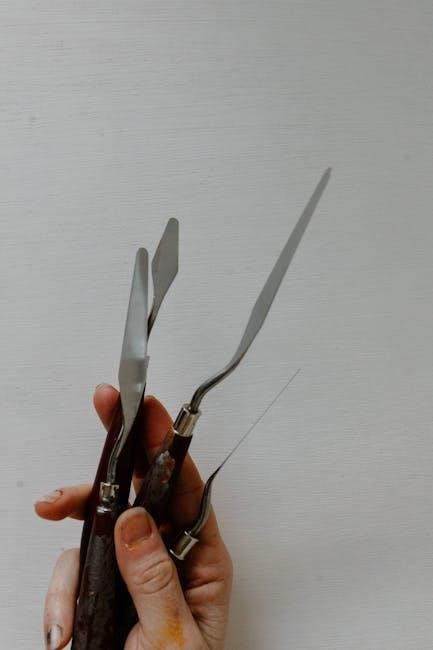A Tool Box Talk on manual handling is a concise, interactive session designed to promote safe practices, preventing injuries and ensuring a safer workplace.
What is a Tool Box Talk?
A Tool Box Talk is a short, interactive session focused on specific safety topics, such as manual handling. It provides a platform for discussing hazards, best practices, and safe techniques to prevent injuries. These talks are typically conducted in a group setting, encouraging worker participation and feedback. They are concise, practical, and designed to reinforce safety awareness and compliance in the workplace. Regular Tool Box Talks help foster a culture of safety and responsibility among employees.
Importance of Manual Handling in Workplace Safety
Manual handling is a critical aspect of workplace safety, as it directly impacts employee well-being and overall productivity. Improper manual handling techniques are a leading cause of workplace injuries, which can result in pain, lost time, and increased costs for employers. Prioritizing safe manual handling practices reduces the risk of injuries, improves workplace morale, and fosters a culture of safety and responsibility. Proper training and awareness are essential to protecting employees and ensuring a safer work environment.
Objective of the Manual Handling Tool Box Talk
The primary objective of a manual handling Tool Box Talk is to promote safe practices, reduce workplace injuries, and ensure compliance with safety regulations. It aims to educate employees on proper lifting techniques, risk assessment, and the use of mechanical aids. By fostering an interactive and engaging environment, the talk encourages active participation and feedback, empowering workers to adopt safer manual handling habits and contribute to a injury-free workplace culture.

Understanding Manual Handling
Manual handling involves lifting, pushing, pulling, or carrying objects, impacting workplace safety. Understanding proper techniques and risks is crucial for preventing injuries and promoting safe practices effectively.
Definition of Manual Handling
Manual handling refers to the transportation or support of a load by hand, involving activities like lifting, pulling, pushing, or carrying objects. It is a common workplace task that, when performed incorrectly, can lead to injuries. Proper techniques and risk assessments are essential to ensure safety and minimize the potential for harm to employees. Understanding manual handling is critical for maintaining a safe and healthy work environment.
Types of Manual Handling Tasks
Manual handling tasks involve activities like lifting, carrying, pushing, and pulling loads. These tasks are common in various industries and can vary in complexity. They include individual efforts, such as lifting tools or equipment, and team-based tasks, like moving heavy or bulky items. Recognizing the different types of manual handling tasks is essential for assessing risks and implementing appropriate safety measures to prevent injuries and ensure a safe working environment.
Risk Factors Associated with Manual Handling
Risk factors in manual handling include tasks requiring repetitive lifting, awkward postures, or excessive force. Individual factors like physical fitness and pre-existing injuries also play a role. Load-related risks involve heavy, unstable, or hard-to-grip objects, while environmental factors such as uneven surfaces or poor lighting can increase hazards. Understanding these risks is crucial for preventing injuries and ensuring a safer workplace through proper assessment and control measures.
The TILE Principle (Task, Individual, Load, Environment)
The TILE Principle is a framework for assessing manual handling risks. Task involves the nature of the activity, such as repetitive movements or awkward postures. Individual considers the person’s physical capabilities and health. Load refers to the weight, size, and stability of the object being handled. Environment assesses workspace conditions, including obstacles, lighting, and floor surfaces. This principle helps identify and mitigate risks to ensure safer manual handling practices.

Legal and Regulatory Responsibilities
Workplace health and safety regulations require employers to ensure safe manual handling practices, providing training and risk assessments to minimize injuries and comply with legal standards.
Overview of Workplace Health and Safety Regulations
Workplace health and safety regulations mandate employers to implement safe manual handling practices, conduct risk assessments, and provide training to minimize injuries. These regulations emphasize the importance of proper lifting techniques, mechanical aids, and ergonomic workplace design to reduce risks. Employers must ensure compliance with legal standards, while employees are expected to follow guidelines and report hazards. Regular updates to regulations reflect advancements in safety practices and injury prevention strategies.
Employer’s Responsibilities in Manual Handling
Employers must conduct risk assessments, provide training, and ensure safe manual handling practices are implemented. They are responsible for monitoring techniques, providing mechanical aids, and assessing load weights. Employers should create a safe working environment, minimize hazards, and encourage open reporting of incidents. Regular updates to safety protocols and compliance with regulations are essential to protect employees from manual handling injuries and promote a culture of safety.
Employee’s Role in Safe Manual Handling Practices
Employees must adhere to safe manual handling practices, use proper lifting techniques, and maintain good posture. They should assess loads using the TILE principle and report unsafe conditions. Employees are responsible for following training guidelines, using PPE when required, and seeking assistance when needed. Active participation in safety discussions and reporting injuries promptly are essential to ensure a safe working environment and prevent manual handling injuries.

Risk Assessment for Manual Handling
Risk assessment is crucial for identifying hazards and evaluating risks in manual handling tasks. It helps implement controls to minimize injuries and ensure a safer workplace.
Steps to Conduct a Manual Handling Risk Assessment
To conduct a manual handling risk assessment, identify hazards, evaluate risks, and implement controls. Start by observing tasks and consulting workers. Use the TILE principle to assess the task, individual, load, and environment. Evaluate the risk level and prioritize actions. Implement controls like mechanical aids or task redesign. Monitor and review the assessment regularly to ensure effectiveness and adapt to changes in the workplace.
Identifying Hazards in Manual Handling Tasks
Identify hazards by observing tasks, consulting workers, and assessing the environment. Common hazards include heavy or unstable loads, awkward postures, and slippery surfaces; Use the TILE principle to evaluate tasks, individual capabilities, load characteristics, and environmental factors. Recognize repetitive movements, insufficient space, and uneven terrain as potential risks. Document findings to prioritize controls and reduce injury risks effectively.
Evaluating the Risks and Implementing Controls
Evaluate risks by assessing task demands, individual capabilities, and environmental factors. Implement controls like mechanical aids, ergonomic adjustments, and task redesign. Prioritize elimination or reduction of manual handling where possible. Train workers on proper techniques and ensure regular monitoring. Use PPE if necessary and review controls periodically to maintain effectiveness. This proactive approach minimizes injury risks and fosters a safer workplace environment for all employees.

Safe Manual Handling Practices
Adhere to safe manual handling practices by maintaining proper posture, assessing loads before lifting, keeping objects close to the body, and using leg strength. Avoid twisting and jerky movements. Teamwork is crucial for heavy tasks to prevent injuries.
Proper Lifting Techniques
Proper lifting techniques are essential to prevent injuries. Stand with feet shoulder-width apart, bend at the knees, and keep the back straight. Grip the load firmly, lift with leg muscles, and keep the object close to the body. Avoid twisting and use smooth, controlled movements. Ensure the path is clear and communicate if teamwork is required. Always assess the load’s weight and size before lifting to maintain balance and control throughout the task;
Best Practices for Carrying and Lowering Loads
When carrying loads, maintain a straight back, keep the load close to your body, and use handles or grips if available. Walk with small steps, avoid overloading, and ensure the path is clear. To lower a load, bend at the knees, keep the object close, and place it gently on a stable surface. Avoid dropping or throwing loads. Always check the environment for obstacles and use mechanical aids when possible to reduce strain and ensure safe handling.
Importance of Posture and Body Mechanics
Maintaining proper posture and body mechanics is crucial to prevent injuries during manual handling. A straight back, bent knees, and balanced stance reduce strain on muscles. Incorrect postures, such as twisting or overreaching, can lead to long-term damage. Using leg muscles instead of the back ensures efficient lifting and minimizes risk. Awareness of body positioning helps maintain control and stability while handling loads, promoting safety and efficiency in the workplace.
Using Personal Protective Equipment (PPE)
Personal Protective Equipment (PPE) plays a vital role in manual handling safety. Gloves protect hands from cuts and abrasions, while back supports maintain proper posture. Ensure PPE is suitable for the task and worn correctly to minimize injury risks. Regularly inspect and maintain PPE to ensure effectiveness. Employers should provide appropriate PPE, and employees must use it consistently alongside proper lifting techniques to enhance workplace safety and reduce manual handling hazards.
Environment and Workplace Setup
A safe working environment minimizes obstacles and hazards, ensuring adequate lighting and space for manual handling tasks to reduce injury risks and improve efficiency.
Ensuring a Safe Working Environment
A safe working environment involves minimizing obstacles, ensuring adequate lighting, and managing workspace layout to prevent manual handling injuries. Clear clutter, avoid tripping hazards, and ensure proper lighting to enhance visibility. Regularly inspect the workspace and adjust layouts to accommodate manual handling tasks effectively. A well-organized environment reduces risks and improves efficiency, aligning with the TILE principle to ensure tasks are performed safely.
Minimizing Obstacles and Hazards
Minimizing obstacles and hazards is critical for safe manual handling. Clear clutter, secure loose cables, and ensure walkways are unobstructed. Use signage to highlight potential risks and store materials in designated areas. Regularly inspect the workspace to identify and address hazards promptly. A clean and organized environment reduces tripping risks and improves visibility, aligning with the TILE principle to enhance safety and efficiency in manual handling tasks.
Importance of Adequate Lighting and Space
Adequate lighting and space are vital for safe manual handling. Proper lighting reduces eye strain and helps identify obstacles, while sufficient space prevents awkward postures and collisions. Ensure work areas are well-lit, free from shadows, and have enough room for movement. Clear pathways and adequate space minimize risks, enabling workers to maneuver safely and maintain proper body mechanics, aligning with the TILE principle to enhance safety and efficiency in manual handling tasks.

Manual Handling and Teamwork
Teamwork in manual handling enhances safety and efficiency by promoting collaboration, communication, and shared responsibility, ensuring tasks are performed with proper coordination and mutual support to prevent injuries.
Team Handling Techniques
Team handling involves clear communication, role assignment, and synchronized movement to safely manage heavy or awkward loads. Assigning roles ensures each person understands their responsibility, reducing the risk of accidents. Proper coordination and timing are crucial to avoid strain or injury. Techniques include lifting in unison, maintaining a firm grip, and using mechanical aids when possible. Effective teamwork distributes the load’s weight evenly, minimizing individual strain and enhancing overall safety and efficiency in manual handling tasks.
Communication and Coordination in Manual Handling
Clear communication and coordination are essential for safe manual handling, especially in team tasks. Ensure roles are assigned and understood before starting. Use hand signals or verbal cues to synchronize movements, avoiding misunderstandings. Proper planning and briefing ensure alignment and reduce risks. Effective teamwork enhances safety by distributing the load evenly and minimizing individual strain, ultimately preventing accidents and promoting a collaborative work environment.
When to Seek Assistance
Seek assistance when a load exceeds your capacity or poses a risk. Always ask for help if a task involves heavy, awkward, or unstable objects. Assess the weight, size, and stability of the load beforehand. Don’t hesitate to request support to prevent injuries. Use mechanical aids or team handling when possible. Remember, prioritizing safety ensures a healthier and more efficient workplace for everyone involved.

Preventing Manual Handling Injuries
Preventing manual handling injuries involves eliminating tasks where possible, using mechanical aids, and assessing risks. Proper techniques, ergonomic design, and regular training reduce injury risks effectively;
Strategies to Eliminate Manual Handling Where Possible
Eliminating manual handling involves identifying tasks that can be automated or modified. Use mechanical aids like hoists or trolleys, redesign tasks to reduce lifting, and implement ergonomic solutions. Assessing workflows to minimize heavy or repetitive tasks is crucial. Training employees to recognize and report unsafe tasks encourages proactive elimination. Prioritizing machinery or equipment that reduces physical strain can significantly lower injury risks and enhance workplace efficiency.
Using Mechanical Aids and Equipment
Implementing mechanical aids like hoists, trolleys, and conveyors can significantly reduce manual handling risks. These tools help lift, move, and position loads efficiently, minimizing physical strain. Proper training on equipment operation and regular maintenance are essential to ensure safety and effectiveness. By incorporating mechanical aids, workplaces can reduce injury risks and enhance overall efficiency, promoting a safer environment for employees.
Ergonomic Design and Workplace Layout
Ergonomic design focuses on optimizing workspaces to reduce physical strain. Proper layout ensures tools and materials are within easy reach, minimizing stretching and bending. Adjustable workstations and clear pathways reduce awkward postures and tripping hazards. Good lighting and task-specific equipment design further enhance safety. By aligning tasks with worker capabilities, ergonomic design significantly lowers manual handling risks and improves overall workplace efficiency and safety.

Common Injuries from Manual Handling
Manual handling often leads to injuries like back strains, muscle pulls, and joint sprains. Improper lifting techniques can cause long-term damage, affecting worker health and productivity.
Types of Injuries Caused by Poor Manual Handling
Poor manual handling often results in musculoskeletal disorders, back strains, herniated discs, and sprains. Repetitive tasks can cause tendinitis or nerve damage, while improper lifting may lead to fractures or chronic pain. In severe cases, injuries can result in long-term disabilities, affecting an individual’s ability to work and maintain overall well-being. These injuries highlight the urgency of adopting safe manual handling practices to protect worker health and safety.
Long-Term Consequences of Manual Handling Injuries
Manual handling injuries can lead to chronic pain, limited mobility, and long-term disabilities, impacting daily life and work capacity. Prolonged musculoskeletal issues may require ongoing medical care, reducing productivity and increasing healthcare costs. Mental health challenges, such as anxiety or depression, can also arise from persistent pain or inability to work. These consequences underscore the importance of prevention and proper manual handling techniques to safeguard workers’ long-term well-being and career longevity.

Case Studies and Real-Life Examples
Real-life incidents highlight how poor manual handling caused injuries, such as lifting heavy tools improperly. Successful implementations of safe practices reduced workplace injuries significantly, ensuring safer environments.
Common Scenarios Leading to Manual Handling Injuries
Manual handling injuries often occur when lifting heavy objects improperly, carrying loads with poor posture, or failing to use mechanical aids. Tasks like lifting tools or equipment from awkward positions can strain muscles, leading to injuries. Neglecting to assess load weight or overestimating personal capacity also contributes to harm. These scenarios highlight the importance of proper training and regular toolbox talks to prevent such incidents and ensure worker safety.
Successful Implementation of Safe Manual Handling Practices
Successful implementation involves eliminating manual handling where possible, using mechanical aids, and ensuring proper training. Ergonomic workplace design and adherence to the TILE principle (Task, Individual, Load, Environment) are key. Encouraging regular toolbox talks and fostering a culture of safety help reduce injuries. Proper lifting techniques, posture awareness, and employee participation are essential. These strategies collectively create a safer work environment and minimize manual handling risks.

Tool Box Talk Delivery and Engagement
Effective delivery involves conducting interactive sessions, encouraging employee participation, and using visual aids to reinforce safe practices. Prepare a quiet, distraction-free location for the talk.
How to Conduct an Effective Tool Box Talk
Prepare thoroughly, ensuring a quiet, distraction-free environment. Use visual aids like diagrams or videos to enhance understanding. Encourage open discussion and questions, fostering active participation. Clearly outline key safety practices, such as proper lifting techniques and hazard identification. Summarize the session with actionable takeaways and provide resources for further learning. Follow up by assessing understanding and reinforcing the importance of safe manual handling in daily tasks.
Encouraging Employee Participation and Feedback
Create a supportive environment where employees feel comfortable sharing their experiences and concerns. Ask open-ended questions to stimulate discussion and encourage active participation. Use visual aids and real-life examples to make the topic relatable. Recognize and reward contributions to foster engagement. Emphasize the importance of feedback in improving safety practices and invite suggestions for future topics. This collaborative approach ensures employees are invested in maintaining a safe workplace.
Using Visual Aids and Resources
Visual aids like diagrams, videos, and props can make manual handling discussions more engaging and effective. Use images to demonstrate proper lifting techniques and highlight hazards. Videos can show real-life scenarios and solutions. Incorporate props, such as tools or equipment, to provide hands-on examples. Offer downloadable resources, like PDF guides, for employees to reference later. These tools enhance understanding, retention, and practical application of safe manual handling practices in the workplace;
Regular toolbox talks on manual handling are crucial for fostering a safety-first culture. Continuous training and feedback ensure sustained improvement in workplace practices and injury prevention.
Understanding manual handling risks and applying the TILE principle is essential. Proper lifting techniques, posture, and PPE use significantly reduce injury risks. A safe environment, teamwork, and regular training further enhance safety. Encouraging open communication and feedback fosters a culture of continuous improvement. Prioritizing mechanical aids and ergonomic design minimizes manual handling needs. Regular toolbox talks ensure sustained awareness and adherence to safe practices, protecting workers and promoting a healthier workplace.
Creating an Action Plan for Safe Manual Handling
Develop a structured plan to assess manual handling tasks using the TILE principle. Identify ways to minimize manual handling by using mechanical aids. Provide training on proper techniques and ensure regular supervision. Monitor compliance and review the plan periodically to adapt to workplace changes. Encourage employee feedback to improve safety measures and foster a proactive approach to injury prevention.
Resources for Further Learning
Access downloadable PDF guides, training modules, and safety protocols for manual handling. Utilize online resources from health and safety organizations, such as HSE and MinEx, to deepen understanding. Explore interactive tools and videos demonstrating proper techniques. Encourage employees to review these materials to enhance their knowledge and practice of safe manual handling in the workplace. Stay informed with updated guidelines and best practices to maintain a safe work environment.

